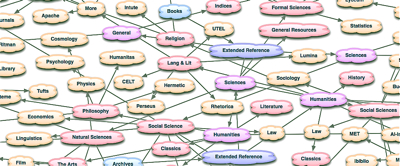Difference between revisions of "Schematic"
(New page: Image:lighterstill.jpgleft|frame A '''schematic''' is a diagram that represents the elements of a system using abstract, graphic [[symbol...) |
m (Text replacement - "http://" to "https://") |
||
| (2 intermediate revisions by one other user not shown) | |||
| Line 1: | Line 1: | ||
| − | [[Image:lighterstill.jpg]][[Image:Daynal_index_(partial_view).jpg| | + | [[Image:lighterstill.jpg]] [[Image:Daynal_index_(partial_view).jpg|right|frame|<center>Partial schematic view of [https://www.daynal.org Daynal Institute] website index]] |
| − | A '''schematic''' is a diagram that represents the elements of a [[system]] using abstract, graphic [[symbol]]s rather than realistic pictures. A schematic usually omits all details that are not relevant to the information the schematic is intended to convey, and may add unrealistic elements that aid comprehension. | + | A '''schematic''' is a diagram that represents the elements of a [[system]] using abstract, graphic [[symbol]]s rather than realistic pictures. A schematic usually omits all details that are not relevant to the information the schematic is intended to convey, and may add unrealistic elements that aid comprehension. In the schematic diagram, the symbolic elements are arranged to be more easily interpreted by the viewer. |
== Electrical and electronic industry == | == Electrical and electronic industry == | ||
| Line 23: | Line 23: | ||
== External links== | == External links== | ||
| − | * [ | + | * [https://www.web-ee.com/Schematics/schematics.htm WebEE Schematics and Projects ] Many Circuits and Electronic Projects. |
| − | * [ | + | * [https://discovercircuits.com Discover Circuits ] Large collection of electronic circuit schematics. |
[[Category: General Reference]] | [[Category: General Reference]] | ||
Latest revision as of 02:10, 13 December 2020

A schematic is a diagram that represents the elements of a system using abstract, graphic symbols rather than realistic pictures. A schematic usually omits all details that are not relevant to the information the schematic is intended to convey, and may add unrealistic elements that aid comprehension. In the schematic diagram, the symbolic elements are arranged to be more easily interpreted by the viewer.
Electrical and electronic industry
In electronic design automation, until the 1980's, schematics were virtually the only formal representation for circuits. More recently, with the progress of computer technology, other representations were introduced and specialized computer languages were developed, since with the explosive growth of the complexity of electronic circuits, traditional schematics are becoming less practical. For example, hardware description languages are indispensable for modern digital circuit design.
Schematics for electronic circuits are prepared by designers using EDA (Electronic Design Automation) tools called schematic capture tools or schematic entry tools. These tools go beyond simple drawing of devices and connections. Usually they are integrated into the whole IC design flow and linked to other EDA tools for verification and simulation of the circuit under design.
In electric power systems design, a schematic drawing called a one-line diagram is frequently used to represent substations, distribution systems or even whole electrical power grids. These diagrams simplify and compress the details that would be repeated on each phase of a three-phase system, showing only one element instead of three.
Schematics in repair manuals
Schematic diagrams are used extensively in repair manuals to help users understand the relative position of parts and to provide graphical instruction to assist in taking apart and rebuilding mechanical assemblies. Many automotive and motorcycle repair manuals devote a significant number of pages to schematic diagrams.
See also
External links
- WebEE Schematics and Projects Many Circuits and Electronic Projects.
- Discover Circuits Large collection of electronic circuit schematics.